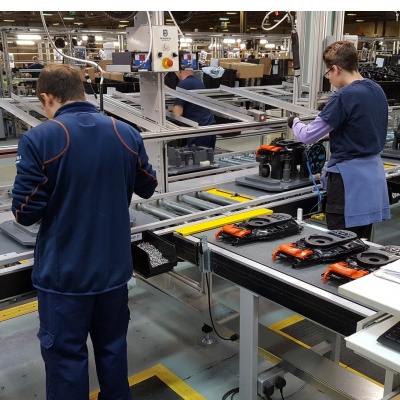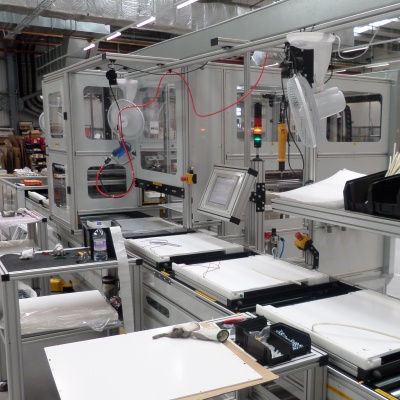The assembly line, made famous by Henry Ford who is widely credited for using the first moving assembly line in Ford back in 1913, is a manufacturing process whereby the product being built moves along a conveyor stopping at workstations along the way.

These days assembly lines can vary from very simple, almost unchanged from Henry Ford’s days, to complex, where there is very little human interaction with the product and the manufacturing processes on the line are handled by automation and robotics.
Benefits of automated conveyor assembly lines
Manufacturing is more reliant than ever on automation to increase output capacity and enhance efficiency. Here are some of the benefits of investing in an assembly line:
- Specialisation of labour. Assembly lines allow workers and machines/robots to specialise in a specific task, which can lead to increased productivity and efficiency. Rather than have teams of people each building the same product you can break the assembly process down into steps and have workstations for each step. By having people concentrate solely on one part of the build process they have less to think about and can specialise in their task. Also since each employee performs a single role, your investment in training and development is reduced.
- Product uniformity. By splitting the assembly of your product up into separate processes you will start to see a much more consistent and uniform final product. If one person created an entire product from scratch, his or her product could differ significantly from the product put together by another employee.
- Faster and more efficient production. A well considered and designed assembly line can improve the speed at which products can be built. By splitting the assembly of the product up into sections you can analyse easier where time savings can be made. A well designed assembly line will not only deliver the product to the workstation it will also have all of the required components and tools to hand so tasks can be carried out as efficiently as possible.
Conveyor Assembly Line Considerations
Adding an automated conveyor assembly line or production line to your production process may seem like a great way to move your production to the next level but there are a number of factors for you to consider. (At this point it is always a good idea to have a chat with the experts and Advance offer a free consultation service so get in touch).
- Initial cost. An automated assembly line can be a big investment, particularly for companies looking to make their first steps into automation. Obviously the cost and ROI need to be carefully considered with any capital investment. By chatting to a manufacturer of conveyors and assembly lines you will be able to look at options, for example is there an option to start small and expand on the system as the business grows?
- Available space. A lot of assembly lines run in a straight line so you are going to want to look at what space you have available. Factors that you need to consider when looking at space are the size of your product, the number of operations the product needs to go through and whether you need access to or around the system for maintenance, forklifts etc.
- Return system. With a lot of assembly systems and automated production lines the product itself travels down the assembly sitting on a pallet, jig or tote. Once completed the finished product is removed from the line but what happens to the empty pallets? You could simply remove them and take them back to the start manually but that adds an element of manual labour back in to your process. A popular way of returning pallets is to either transfer them onto a return line running parallel to the assembly line or return them underneath via lifts at either end.
- How automated do you want to be? With higher levels of automation come higher initial financial outlays however, depending on a number of factors, the pay back period could be much better. Assembly lines can just be a way of adding some conveyor systems to your process to make manufacturing your product quicker and more efficient, whilst at the same time making it more ergonomically comfortable for your employees. They can also be a way, through the addition of automation and robotics to reduce your labour overheads and automate the manufacture of your product.
- Is it designed for you? When buying a common item like a pallet truck for example it is usually safe to go for an "off the shelf" product, as long as it will fit your pallets and has the lift capacity you are fine. Buying an assembly line that has not been designed to suit your product, your factory layout, your manufacture process and your end goals however is a recipe for disaster.
What type of conveyors are used in assembly lines?
This can vary massively and depends greatly on what you are assembling on the line and how it will be transported, i.e. will the product be on a pallet or jig or will it be travelling on it's own?
Usually the most cost effective options are to manufacture the assembly lines out of powered roller conveyors or belt conveyors. Overhead conveyors where the product is suspended from a carrier and is worked on as it travels along the system are also regularly used as assembly lines.
For more bespoke products and applications there are other options that can be considered.
Speak to a UK manufacturer of automated conveyor assembly lines
Advance have worked with a number of UK businesses to design, manufacture and install automated assembly lines.
If you would like to know more or speak to one of our experienced sales engineers get in touch now.
Published: 12th June 2018

